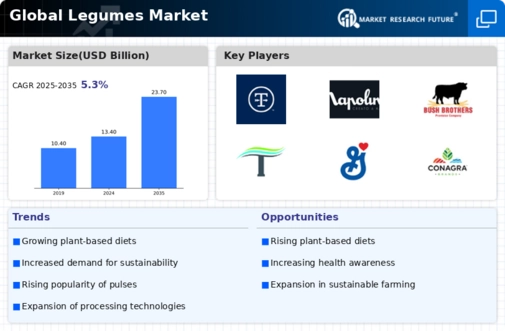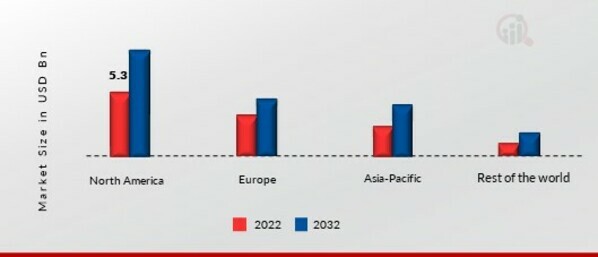-
1 EXECUTIVE SUMMARY
-
Market Attractiveness Analysis
- Global Legumes Market, by Source
- Global Legumes Market, by Product Type
- Global Legumes Market, by End Use
- Global Legumes Market, by Region
-
MARKET INTRODUCTION
-
Definition
-
Scope of the Study
-
Market Structure
-
Key Buying Criteria
-
Macro Factor Indicator Analysis
-
RESEARCH METHODOLOGY
-
Research Process
-
Primary Research
-
Secondary Research
-
Market Size Estimation
-
Forecast Model
-
List of Assumptions
-
MARKET DYNAMICS
-
Introduction
-
Drivers
-
Restraints
-
Opportunities
-
Challenges
-
MARKET FACTOR ANALYSIS
-
Value Chain Analysis
-
Supply Chain Analysis
-
Porter’s Five Forces Model
- Bargaining Power of Suppliers
- Bargaining Power of Buyers
- Threat of New Entrants
- Threat of Substitutes
- Intensity of Rivalry
-
GLOBAL LEGUMES MARKET, BY SOURCE
-
Introduction
-
Beans
- Beans: Market Estimates & Forecast, by Region/Country, 2025–2034
-
Lentils
- Lentils: Market Estimates & Forecast, by Region/Country, 2025–2034
-
Peas
- Peas: Market Estimates & Forecast, by Region/Country, 2025–2034
-
Others
- Others: Market Estimates & Forecast, by Region/Country, 2025–2034
-
GLOBAL LEGUMES MARKET, BY PRODUCT TYPE
-
Introduction
-
Whole
- Whole: Market Estimates & Forecast, by Region/Country, 2025–2034
-
Flour
- Flour: Market Estimates & Forecast, by Region/Country, 2025–2034
-
Oil
- Oil: Market Estimates & Forecast, by Region/Country, 2025–2034
-
Others
- Others: Market Estimates & Forecast, by Region/Country, 2025–2034
-
GLOBAL LEGUMES MARKET, BY END USE
-
Introduction
-
Household
- Household: Market Estimates & Forecast, by Region/Country, 2025–2034
-
Commercial
- Food Service
- Food Processing
-
GLOBAL LEGUMES MARKET, BY REGION
-
Introduction
-
North America
- Market Estimates & Forecast, by Source, 2025–2034
- Market Estimates & Forecast, by Product Type, 2025–2034
- Market Estimates & Forecast, by End Use, 2025–2034
- Market Estimates & Forecast, by Country, 2025–2034
- US
- Canada
- Mexico
-
Europe
- Market Estimates & Forecast, by Source, 2025–2034
- Market Estimates & Forecast, by Product Type, 2025–2034
- Market Estimates & Forecast, by End Use, 2025–2034
- Market Estimates & Forecast, by Country, 2025–2034
- Germany
- UK
- France
- Spain
- Italy
- Rest of Europe
-
Asia-Pacific
- Market Estimates & Forecast, by Source, 2025–2034
- Market Estimates & Forecast, by Product Type, 2025–2034
- Market Estimates & Forecast, by End Use, 2025–2034
- Market Estimates & Forecast, by Country, 2025–2034
- China
- Japan
- India
- Australia & New Zealand
- Rest of Asia-Pacific
-
Rest of the World
- Market Estimates & Forecast, by Source, 2025–2034
- Market Estimates & Forecast, by Product Type, 2025–2034
- Market Estimates & Forecast, by End Use, 2025–2034
- Market Estimates & Forecast, by Region, 2025–2034
- South America
- Middle East
- Africa
-
COMPETITIVE LANDSCAPE
-
Introduction
-
Competitive Benchmarking
-
Development Share Analysis
-
Key Developments & Growth Strategies
-
COMPANY PROFILES
-
B&G Foods
- Company Overview
- Financial Overview
- Products Offered
- Key Developments
- SWOT Analysis
- Key Strategies
-
The Archer Daniels Midland Company
- Company Overview
- Financial Overview
- Products Offered
- Key Developments
- SWOT Analysis
- Key Strategies
-
Conagra Brands Inc
- Company Overview
- Financial Overview
- Products Offered
- Key Developments
- SWOT Analysis
- Key Strategies
-
Eden Foods Inc
- Company Overview
- Financial Overview
- Products Offered
- Key Developments
- SWOT Analysis
- Key Strategies
-
Dunns Limited
- Company Overview
- Financial Overview
- Products Offered
- Key Developments
- SWOT Analysis
- Key Strategies
-
Olam International
- Company Overview
- Financial Overview
- Products Offered
- Key Developments
- SWOT Analysis
- Key Strategies
-
General Mills Inc
- Company Overview
- Financial Overview
- Products Offered
- Key Developments
- SWOT Analysis
- Key Strategies
-
Galdisa USA
- Company Overview
- Financial Overview
- Products Offered
- Key Developments
- SWOT Analysis
- Key Strategies
-
Nomad Foods
- Company Overview
- Financial Overview
- Products Offered
- Key Developments
- SWOT Analysis
- Key Strategies
-
Puris Proteins, LLC
- Company Overview
- Financial Overview
- Products Offered
- Key Developments
- SWOT Analysis
- Key Strategies
-
ILRAMA AGRO LLC
- Company Overview
- Financial Overview
- Products Offered
- Key Developments
- SWOT Analysis
- Key Strategies
-
Nefis Bulgar Ltd.
- Company Overview
- Financial Overview
- Products Offered
- Key Developments
- SWOT Analysis
- Key Strategies
-
BIMARKET LLC
- Company Overview
- Financial Overview
- Products Offered
- Key Developments
- SWOT Analysis
- Key Strategies
-
AGT Foods USA
- Company Overview
- Financial Overview
- Products Offered
- Key Developments
- SWOT Analysis
- Key Strategies
-
Anchor Ingredients Co, LLC
- Company Overview
- Financial Overview
- Products Offered
- Key Developments
- SWOT Analysis
- Key Strategies
-
APPENDIX
-
General Sources & References
-
List of Abbreviations
-
-
List of Tables
-
Global Legumes Market, by Region, 2025–2034 (USD Million)
-
Global Legumes Market, by Source, 2025–2034 (USD Million)
-
Global Legumes Market, by Product Type, 2025–2034 (USD Million)
-
Global Legumes Market, by End Use, 2025–2034 (USD Million)
-
North America: Legumes Market, by Country, 2025–2034 (USD Million)
-
North America: Legumes Market, by Source, 2025–2034 (USD Million)
-
North America: Legumes Market, by Product Type, 2025–2034 (USD Million)
-
North America: Legumes Market, by End Use, 2025–2034 (USD Million)
-
US: Legumes Market, by Source, 2025–2034 (USD Million)
-
US: Legumes Market, by Product Type, 2025–2034 (USD Million)
-
US: Legumes Market, by End Use, 2025–2034 (USD Million)
-
Canada: Legumes Market, by Source, 2025–2034 (USD Million)
-
Canada: Legumes Market, by Product Type, 2025–2034 (USD Million)
-
Canada: Legumes Market, by End Use, 2025–2034 (USD Million)
-
Mexico: Legumes Market, by Source, 2025–2034 (USD Million)
-
Mexico: Legumes Market, by Product Type, 2025–2034 (USD Million)
-
Mexico: Legumes Market, by End Use, 2025–2034 (USD Million)
-
Europe: Legumes Market, by Country, 2025–2034 (USD Million)
-
Europe: Legumes Market, by Source, 2025–2034 (USD Million)
-
Europe: Legumes Market, by Product Type, 2025–2034 (USD Million)
-
Europe: Legumes Market, by End Use, 2025–2034 (USD Million)
-
Germany: Legumes Market, by Source, 2025–2034 (USD Million)
-
Germany: Legumes Market, by Product Type, 2025–2034 (USD Million)
-
Germany: Legumes Market, by End Use, 2025–2034 (USD Million)
-
France: Legumes Market, by Source, 2025–2034 (USD Million)
-
France: Legumes Market, by Product Type, 2025–2034 (USD Million)
-
France: Legumes Market, by End Use, 2025–2034 (USD Million)
-
Italy: Legumes Market, by Source, 2025–2034 (USD Million)
-
Italy: Legumes Market, by Product Type, 2025–2034 (USD Million)
-
Italy: Legumes Market, by End Use, 2025–2034 (USD Million)
-
Spain: Legumes Market, by Source, 2025–2034 (USD Million)
-
Spain: Legumes Market, by Product Type, 2025–2034 (USD Million)
-
Spain: Legumes Market, by End Use, 2025–2034 (USD Million)
-
UK: Legumes Market, by Source, 2025–2034 (USD Million)
-
UK: Legumes Market, by Product Type, 2025–2034 (USD Million)
-
UK: Legumes Market, by End Use, 2025–2034 (USD Million)
-
Rest of Europe: Legumes Market, by Source, 2025–2034 (USD Million)
-
Rest of Europe: Legumes Market, by Product Type, 2025–2034 (USD Million)
-
Rest of Europe: Legumes Market, by End Use, 2025–2034 (USD Million)
-
Asia-Pacific: Legumes Market, by Country, 2025–2034 (USD Million)
-
Asia-Pacific: Legumes Market, by Source, 2025–2034 (USD Million)
-
Asia-Pacific: Legumes Market, by Product Type, 2025–2034 (USD Million)
-
Asia-Pacific: Legumes Market, by End Use, 2025–2034 (USD Million)
-
China: Legumes Market, by Source, 2025–2034 (USD Million)
-
China: Legumes Market, by Product Type, 2025–2034 (USD Million)
-
China: Legumes Market, by End Use, 2025–2034 (USD Million)
-
India: Legumes Market, by Source, 2025–2034 (USD Million)
-
India: Legumes Market, by Product Type, 2025–2034 (USD Million)
-
India: Legumes Market, by End Use, 2025–2034 (USD Million)
-
Japan: Legumes Market, by Source, 2025–2034 (USD Million)
-
Japan: Legumes Market, by Product Type, 2025–2034 (USD Million)
-
Japan: Legumes Market, by End Use, 2025–2034 (USD Million)
-
Rest of Asia-Pacific: Legumes Market, by Source, 2025–2034 (USD Million)
-
Rest of Asia-Pacific: Legumes Market, by Product Type, 2025–2034 (USD Million)
-
Rest of Asia-Pacific: Legumes Market, by End Use, 2025–2034 (USD Million)
-
Rest of the World (RoW): Legumes Market, by Country, 2025–2034 (USD Million)
-
Rest of the World (RoW): Legumes Market, by Source, 2025–2034 (USD Million)
-
Rest of the World (RoW): Legumes Market, by Product Type, 2025–2034 (USD Million)
-
Rest of the World (RoW): Legumes Market, by End Use, 2025–2034 (USD Million)
-
South America: Legumes Market, by Source, 2025–2034 (USD Million)
-
South America: Legumes Market, by Product Type, 2025–2034 (USD Million)
-
South America: Legumes Market, by End Use, 2025–2034 (USD Million)
-
Middle East: Legumes Market, by Source, 2025–2034 (USD Million)
-
Middle East: Legumes Market, by Product Type, 2025–2034 (USD Million)
-
Middle East: Legumes Market, by End Use, 2025–2034 (USD Million)
-
Africa: Legumes Market, by Source, 2025–2034 (USD Million)
-
Africa: Legumes Market, by Product Type, 2025–2034 (USD Million)
-
Africa: Legumes Market, by End Use, 2025–2034 (USD Million)
-
LIST OF FIGURES
-
Global Legumes Market Segmentation
-
Forecast Research Methodology
-
Five Forces Analysis of the Global Legumes Market
-
Value Chain of the Global Legumes Market
-
Share of the Global Legumes Market in 2023, by Country (%)
-
Global Legumes Market, by Region, 2025–2034,
-
Global Legumes Market Size, by Source, 2023
-
Share of the Global Legumes Market, by Source, 2025–2034 (%)
-
Global Legumes Market Size, by Product Type, 2023
-
Share of the Global Legumes Market, by Product Type, 2025–2034 (%)
-
Global Legumes Market Size, by End Use, 2023
-
Share of the Global Legumes Market, by End Use, 2025–2034 (%)












Leave a Comment